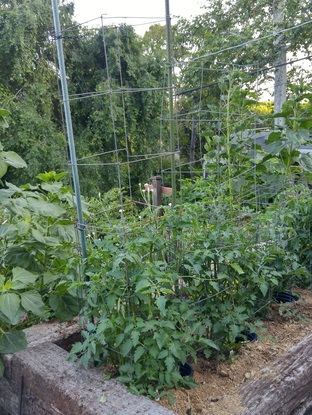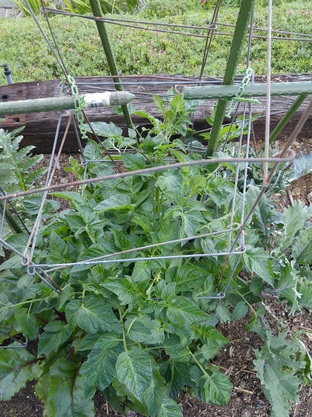Years ago, I’d planted more than a dozen tomato varieties that I knew would grow way taller than the single cages, so I’d also added the second story cages, but not the upright stakes or the horizontal ones. Late in August, when the plants were massive and heavily set with fruit – and I’d just watered them – we had a huge windstorm that resulted in many of the plants being blown horizontal. All that weight and the loose moist soil just couldn’t withstand the wind.
Consequently, each year since then, I’ve created this Jungle Jim of stability, and the magic has worked – no more blown-down tomato plants, despite however tall they’re grown! And some of those Sungolds have indeed grown up through the two cages, over the sides, and back down to the soil – all the while bearing their luscious golden orbs – by the time October and November chill arrived.
Keep Sowing and Transplanting
Our mid-70s and low-80s air temperatures continue to be perfect weather for prepping soil and sowing seeds and transplanting seedlings of summer edibles and bloomers.
If you’ve already planted determinate tomatoes – that’ll grow, bear, and quit – then make a point of purchasing and planting another batch so you’ll continue having tomatoes after those first plants give up.
Repeat sowing seeds of beans, cucumbers, and squash – best done where they’ll grow, now that air and soil temperatures are perfect. I don’t bother starting these big-seeded veggies in seed trays earlier, since at best the transplants may or may not thrive once in the garden compared with starting them in the garden where they’ll mature. Instead, I wait to plant my first seeds in the garden when I see volunteers from last year – then I know the soil’s the perfect conditions and so I sow mine. I learned this years ago when I’d had difficulty getting dill to germinate – when I saw some volunteers, I went ahead and sowed my seed with great success.
When uneven germination occurs, I just sow more seeds where the original ones didn’t. By the time the first-sown ones reach the second tier of the cages, the second-sown ones have reached there as well due to quicker growth because of warmer weather and soil.
Keep Thinning Fruit Trees
Even though the optimum time to thin fruit trees is when fruits are dime-size, any time you can manage is fine. Every week or so I gently push away leaves to see how the fruits underneath are progressing, and I always find some more that I need to remove to prevent their rubbing when they achieve full size. I also remove fruits that are on the tops of the branches, more obvious to birds because they’re not fully covered by the foliage – I don’t want the birds to see any bit of fruit as they fly overhead that will encourage them to land and search for more to peck!
| | |












 RSS Feed
RSS Feed